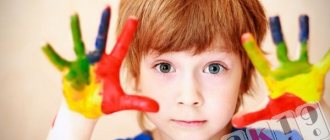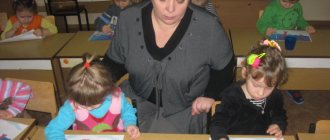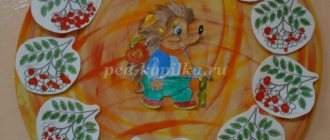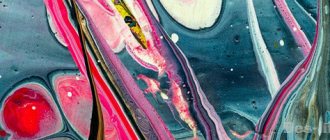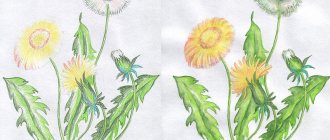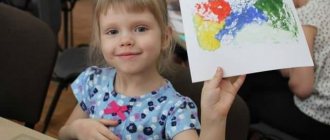Self-education plan for a kindergarten teacher. Unconventional drawing techniques
Self-education plan for a preschool teacher
Topic : Non-traditional drawing techniques in older preschool age. Goals: - To develop the ability to implement acquired knowledge about means of expression in one’s own creativity; — Develop the ability to perform a collective composition, coordinate your actions with peers; — Develop the need to create a new, unusual product of creative activity; — Develop aesthetic appreciation and the desire for creative self-realization. Objectives: - expand the understanding of the variety of non-traditional drawing techniques; — to form an aesthetic attitude to the surrounding reality based on familiarization with non-traditional drawing techniques; - to form aesthetic taste, creativity, imagination; - develop associative thinking and curiosity, observation and imagination; — improve technical and drawing skills; — to cultivate artistic taste and a sense of harmony. Relevance of the topic: “Childhood is an everyday discovery of the world, so we must make sure that it becomes, first of all, the knowledge of man and the Fatherland, their beauty and greatness.” “The origins of children’s abilities and talents are at their fingertips. From the fingers, figuratively speaking, come the finest threads - streams that feed the source of creative thought. In other words, the more skill in a child’s hand, the smarter the child.” V. A. Sukhomlinsky. All children love to draw. Having experienced an interest in creativity, they themselves find the necessary ways. But not everyone succeeds in this, especially since many children are just beginning to master artistic activities. Children love to learn new things and study with pleasure. It is by learning, gaining knowledge and skills that a child feels confident. Drawing with unusual materials and original techniques allows children to experience unforgettable positive emotions. Unconventional drawing gives children a lot of positive emotions, reveals new possibilities for using familiar objects as artistic materials, and surprises them with its unpredictability. Original drawing without a brush or pencil relaxes the child, allows him to feel the colors, their character, and mood. Unbeknownst to themselves, children learn to observe, think, and fantasize. The teacher must awaken in every child faith in his creative abilities, individuality, uniqueness, the belief that he came into this world to create goodness and beauty, to bring joy to people. The relevance is that knowledge is not limited to the program. Children get acquainted with a variety of unconventional drawing methods, their features, the variety of materials used in drawing, and learn to create their own drawings based on the knowledge gained. Thus, a creative personality develops, capable of applying their knowledge and skills in various situations. Drawing with non-traditional techniques is the most important aspect of aesthetic education. Visual activity is one of the most interesting for preschool children: it deeply excites the child and evokes positive emotions. Non-traditional drawing techniques are ways to create a new, original work of art in which everything is in harmony: color, line, and plot. This is a huge opportunity for children to think, try, search, experiment, and most importantly, express themselves. The problem of the development of non-traditional drawing techniques was dealt with by R. G. Kazakova, T. I. Saiganova, E. M. Sedova, V. Yu. Sleptsova, T. V. Smagina, O. V. Nedorezova, V. N. Volchkova, N. V. Stepanova and others. During their stay in the group, children have time to learn various image technologies such as: poking with a hard semi-dry brush, finger painting, cork imprinting, wax crayons + watercolor, object monotype, regular blotography, straw blotography, string blotography, spraying, poking, landscape monotype . The inclusion of non-traditional drawing techniques in working with children makes it possible to develop the sensory sphere not only by studying the properties of depicted objects and performing appropriate actions, but also by working with various visual materials. In addition, the child’s cognitive interest is stimulated (using objects that surround the baby every day from a new perspective - you can draw with your own palm, fingers, or use a spikelet or birch leaf instead of a brush). There is a development of visual-figurative and verbal-logical thinking, and the activation of children’s independent mental activity. (What else can I draw? What can I draw with this material) Through the use of various visual materials, new technical techniques that require precision movements, but do not limit the child’s fingers to a fixed position (as when holding a brush or pencil correctly, conditions are created for the development of general motor awkwardness, development of fine motor skills. After all, instead of the traditional: brush and pencil, the child uses his own palms, various signets, stencils, and the “blotography” technique to create an image. The creation of a complex symmetrical image is facilitated by the “monotype” technique. It is non-traditional drawing techniques that create an atmosphere of ease, openness, relaxedness, contribute to the development of initiative, independence of children, create an emotionally positive attitude towards the activity. The result of visual activity cannot be bad or good, the work of each child is individual, unique. Distribution of equipment by age groups. At older preschool age, children can master even more difficult methods and techniques: - poking with a hard, semi-dry brush. — foam printing; — printing with corks; — wax crayons + watercolor; — candle + watercolor; — leaf prints; - palm drawings; - drawing with cotton swabs; - using cotton pads; — blotography with a tube. sand painting; drawing with soap bubbles; drawing with crumpled paper; blotography with a tube; landscape monotype; stencil printing; subject monotype; plasticineography. Each of these techniques is a little game. Their use allows children to feel more relaxed, bolder, more spontaneous, develops imagination, and gives complete freedom for self-expression. Work plan for self-education 1. Study of educational, reference, scientific and methodological literature: 1. A. A. Fateeva “Drawing without a brush” 2. T. N. Davydova “Drawing with palms” 3. G. N. Davydova “Non-traditional technique drawing in kindergarten" - M. 2007
4. I. A. Lykova “Colored palms” 5. Magazines “Preschool education”, “Educator”. 6. A. V. Nikitina “Non-traditional drawing techniques in kindergarten” 7. I. A. Lykova - “Methodological manual for specialists of preschool educational institutions.” 1. Study of Internet resources. 2. Developing notes and conducting classes using non-traditional drawing techniques in the preparatory group. 3. Conducting OOD in accordance with the work program. 4. Consultation for parents “The importance of drawing in non-traditional ways. Introduction into practice: 1. Development of a work program for September – May on non-traditional drawing techniques in the preparatory group. 2. Workshop for parents “Use of non-traditional techniques and materials in joint creativity with children.” 3. Exhibitions of children's drawings for parents. 4. Consultation for parents “Non-traditional drawing techniques in the development of preschool children.” 5. Report on the topic of self-education at the final teachers’ meeting. No. Section of the plan Dates Form of work Practical conclusions 1. Preparatory stage: analytical and diagnostic. September 2016 Acquaintance with theoretical knowledge about non-traditional drawing techniques, study of literature, selection of technologies, selection of materials. 2. Main stage. October 2016 – March 2022. Testing of various technologies and methods for organizing work with children, working with children and their parents, selection of consultations. Distribution of material at the preschool level, on the Internet. 3. Final stage. April 2022 Diagnostics and monitoring. 4. Generalization. September 2022 Summarizing. Presentation of the results of work on the topic of self-education. Presentation of materials at the teachers' council Download Self-education plan for a kindergarten teacher. Unconventional drawing techniques
We recommend watching:
Hobbies of a kindergarten teacher Features of creating a culture of safety in preschoolers Development of color perception in preschool children Development of mental abilities of preschoolers through children's literature
Similar articles:
Surprising moments in kindergarten classes. Card index
Kindergarten teacher business card
Presentation of kindergarten for parents
Morning exercises in kindergarten in the preparatory group
Features of outdoor games with preschool children
Plan for self-education in the junior group on the topic: “Non-traditional drawing techniques.”
Municipal state-owned preschool educational institution "Kindergarten "Bell" s. Kalinaul, Kazbekovsky district
Self-education plan for the younger group
on the topic of:
"Unconventional drawing techniques"
Prepared and conducted by: teacher
Goimirzaeva Sadiya Abdulaisovna
Self-education plan on the topic: “Non-traditional drawing techniques” (junior group).
Completion deadline: 09/01/2020 – 05/31/2021
Participants:
Educator - Goimirzaeva Sadiya Abdulaisovna, pupils of the junior group, parents of pupils.
Goals:
- the formation of artistic and creative abilities in children of primary preschool age through creative tasks using interesting and unusual visual techniques and unknown material in their work;
— Develop the need to create a new, unusual product of creative activity;
Tasks:
EDUCATIONAL:
— To introduce children to various types of visual arts, the variety of artistic materials and techniques for working with them, to consolidate acquired skills and abilities and to show children the breadth of their possible application.
— To consolidate and enrich children’s knowledge about different types of artistic creativity.
EDUCATIONAL:
— Cultivate hard work and the desire to achieve success through one’s own labor.
— Cultivate attention, accuracy, determination, creativity
self-realization;
DEVELOPMENTAL:
— Develop artistic taste, imagination, ingenuity, spatial imagination;
— Develop a desire to experiment, showing vivid cognitive feelings: surprise, doubt, joy from learning new things.
Relevance:
Drawing is an interesting and useful activity in which pictorial and graphic images are created in a variety of ways using different materials. Visual activities using non-traditional materials and techniques contribute to the child’s development of:
- Fine motor skills and tactile perception;
- Spatial orientation on a sheet of paper, eye and visual perception;
- Attention and perseverance;
- Thinking;
- Fine skills and abilities, observation, aesthetic perception, emotional responsiveness;
- In addition, in the process of this activity, the preschooler develops control and self-control skills.
It is non-traditional drawing techniques that create an atmosphere of ease, openness, relaxedness, contribute to the development of initiative and independence of children, and create an emotionally positive attitude towards activity. The result of visual activity cannot be good or bad; each child’s work is individual and unique. In addition, joint activities and passion for a common cause contribute to the child’s speech development through interpersonal interaction.
Original drawing attracts with its simplicity and accessibility, revealing the possibility of using well-known objects as artistic materials. This is especially clearly visible when working with children before the fine art period, when they have not yet developed the technical skills of working with paints and brushes, when there is still no exact proportional concept of how much water to take, how much gouache... Non-traditional methods of depiction are quite simple in technology and resemble a game . What child wouldn’t be interested in finger painting, making a drawing with his own palm, putting blots on paper and getting a funny picture?
Non-traditional techniques are an impetus for the development of imagination, creativity, the manifestation of independence, initiative, and expression of individuality.
Expected result:
— formation of knowledge about non-traditional methods of drawing in children of primary school age;
- preschoolers’ knowledge of the simplest technical techniques for working with various visual materials;
— the ability of students to independently apply non-traditional drawing techniques;
— increasing the competence of parents of pupils in the issue of drawing using non-traditional techniques.
To develop children's creative abilities, the following methods of non-traditional drawing were used:
1. Finger painting - applying paint to paper using your fingertips. When a finger touches the paper, fingerprints remain on it in the form of round colored spots, and when it is drawn across the paper, lines are obtained. Paints (used gouache)
diluted to the consistency of sour cream. When changing colors, wash your fingers with water and wipe with a napkin.
2. Palm painting - applying a layer of paint to the inside of the palm and applying it to a sheet of paper to make an imprint.
When placing your palm on the paper, you can clench or spread your fingers.
3. Drawing with a stamp (I used foam rubber figures as a stamp)
- applying paint to a specially shaped surface. Applying a layer of paint to paper and pressing down to obtain a colored print.
As a stamp, you can use wooden geometric figures from toy building material or cut out templates of the desired shape.
Before starting the lesson, you should prepare your workplace. The table should have the essentials .
First
(when drawing with fingers or palms)
- a sheet of paper and one paint for each child.
When children learn to paint carefully (wipe their hands with a napkin, do not stain the table or clothes with paint),
you can offer several paints
Due to the characteristics of early childhood, gaming techniques, artistic expression, finger games, physical education, and outdoor games were used in each lesson.
Long-term plan for non-traditional drawing in school. year:
October, November, December
– finger painting:
- “Rain and rain. cap. cap.";
- "Leaf Fall";
- "Snowflakes are flying";
- “Let’s decorate the Christmas tree”;
- "Firework".
January February March
– drawing with palms:
- Team work - “Sun”;
- "Jellyfish";
- "Hedgehog";
- "Poplar branch";
- "A flower for mom."
April, May
–
drawing with stamps
:
- “Fish swim in the water”;
- "Duck";
- "Balls";
- "Caterpillar".
Consultations for parents throughout the year:
- “Is visual activity so important for a child?”
;
- «Unconventional drawing techniques».
4
